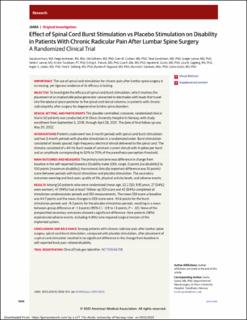| dc.description.abstract | Importance: The use of spinal cord stimulation for chronic pain after lumbar spine surgery is increasing, yet rigorous evidence of its efficacy is lacking. Objective: To investigate the efficacy of spinal cord burst stimulation, which involves the placement of an implantable pulse generator connected to electrodes with leads that travel into the epidural space posterior to the spinal cord dorsal columns, in patients with chronic radiculopathy after surgery for degenerative lumbar spine disorders. Design, setting, and participants: This placebo-controlled, crossover, randomized clinical trial in 50 patients was conducted at St Olavs University Hospital in Norway, with study enrollment from September 5, 2018, through April 28, 2021. The date of final follow-up was May 20, 2022. Interventions: Patients underwent two 3-month periods with spinal cord burst stimulation and two 3-month periods with placebo stimulation in a randomized order. Burst stimulation consisted of closely spaced, high-frequency electrical stimuli delivered to the spinal cord. The stimulus consisted of a 40-Hz burst mode of constant-current stimuli with 4 spikes per burst and an amplitude corresponding to 50% to 70% of the paresthesia perception threshold. Main outcomes and measures: The primary outcome was difference in change from baseline in the self-reported Oswestry Disability Index (ODI; range, 0 points [no disability] to 100 points [maximum disability]; the minimal clinically important difference was 10 points) score between periods with burst stimulation and placebo stimulation. The secondary outcomes were leg and back pain, quality of life, physical activity levels, and adverse events. Results: Among 50 patients who were randomized (mean age, 52.2 [SD, 9.9] years; 27 [54%] were women), 47 (94%) had at least 1 follow-up ODI score and 42 (84%) completed all stimulation randomization periods and ODI measurements. The mean ODI score at baseline was 44.7 points and the mean changes in ODI score were -10.6 points for the burst stimulation periods and -9.3 points for the placebo stimulation periods, resulting in a mean between-group difference of -1.3 points (95% CI, -3.9 to 1.3 points; P = .32). None of the prespecified secondary outcomes showed a significant difference. Nine patients (18%) experienced adverse events, including 4 (8%) who required surgical revision of the implanted system. Conclusions and relevance: Among patients with chronic radicular pain after lumbar spine surgery, spinal cord burst stimulation, compared with placebo stimulation, after placement of a spinal cord stimulator resulted in no significant difference in the change from baseline in self-reported back pain-related disability. Trial registration: ClinicalTrials.gov Identifier: NCT03546738. | |
